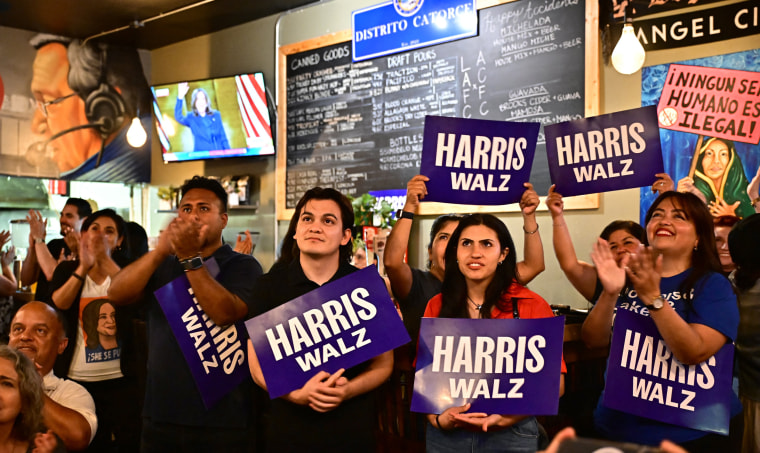It’s still early days, but Vice President Kamala Harris’ performance among Latino voters is looking promising. According to a Economist/YouGov poll released Wednesday, 56% of Latino registered voters prefer Harris, compared to 34% for former President Donald Trump. That’s a significant surge from when President Joe Biden dropped out of the race in July; at that time the same poll found Harris was leading by just 6 percentage points, 44% to 38%. This comes as recent polling data from Equis Research, a research organization focused on the Latino electorate, has found that Harris’ entry into the race has let Democrats “reset” with Latinos and that she is outperforming Biden’s 2024 campaign with this demographic.
Yet despite this good news, Harris has yet to reach Biden’s levels of Latino support in the 2020 campaign, according to Equis. As she looks to rebound even further with Latinos, Harris’ campaign is trying a new tack: approaching them pretty similarly to the way they approach all American voters.
Democrats are experimenting with a new approach to attracting one of the most important demographics in the American electorate.
As The New York Times notes, Harris’ first ad targeting Latino voters, released a few weeks ago, departed from Democrats’ standard messaging toward the demographic in a striking manner. The ad begins with a mention of Harris’ “immigrant mother,” but it makes no explicit mention of Latino identity or immigration as a policy issue. Instead, it discusses Harris’ record and commitment to fighting corporate exploitation, lowering costs of housing and drug prices, and defending abortion rights. In other words — the same set of issues that Harris has been hammering home in her campaign appearances.
The ad represents a gamble: Democrats are experimenting with a new approach to attracting one of the most important demographics in the American electorate in a tight race. But it’s one I’m cautiously optimistic about, because what Democrats were doing previously wasn’t working terribly well.
Latino voters have leaned toward Democrats for decades. But they are not a monolith. For example, a majority of Cuban American registered voters identified as Republicans in 2020, in part because of their familiarity with and objections to the left-wing government in Cuba. Moreover, Latinos are a relatively young demographic and their views are in flux. Trump performed better with Latinos in 2020 than he did in 2016, and since then Latinos have continued to identify with Republican Party in even greater numbers. Biden was looking even worse this time around with the demographic until he dropped out.
For some people, this is counterintuitive. Trump’s offensive comments about immigrants, draconian immigration policies and his nationalism might seem like they would turn off a community of voters who often have ties to recent immigrants — or are immigrants themselves. But the data makes it clear that it’s a mistake to assume that Latinos are categorically different from other Americans when it comes to their positions on immigration and how much they care about the issue.

Earlier this year, Equis found that Latinos in seven battleground states trusted Trump more than Biden on immigration policy. And despite the trope of Latinos as immigration focused, polls find that they’re far more concerned about the economy than anything else — just like most Americans. In other words, it’s not only a mistake to assume Latinos are immigration doves, but also that it’s a top tier issue for them.
Harris has wisely declined to focus heavily on her own racial and gender identity in her campaign, instead placing her focus squarely on kitchen table issues. An approach to Latino voters that channels that same energy — with some targeted tweaks in tone and framing, as the aforementioned ad did effectively — is consistent with that attitude.
There are reasons to think it could bear fruit. Sen. Bernie Sanders’ 2020 presidential campaign was unusually effective at garnering Latino voters, something his Latino press secretary, Belén Sisa, attributed in part to his class-first approach. Here’s how she explained his popularity among Latinos in an interview in 2020:
Bernie’s policies themselves speak to the issues that affect Latinos in their everyday lives. For example, Latinos are the largest uninsured and underinsured group in the country. They don’t have good health care, they’re seeing the impact that has on their health and their finances. Additionally, a lot of Latino families dream of sending their children to university because they didn’t have that opportunity. And they’re realizing that it’s not going to be affordable and this causes a lot of stress.
Harris’ economic policy platform isn’t nearly as progressive as that of Sanders, but its focus on lowering costs and calling out corporations could resonate similarly. Of course, messaging alone won’t do the trick — Sanders’ campaign made a serious push to aggressively invest in Latino outreach from the very beginning of its campaign.
Carlos Odio, a co-founder of Equis, recently emphasized to New York Magazine that Latinos are “the swingiest element of the electorate more broadly, are these low-propensity irregular voters who don’t have fully formed partisan identities.” One thing we know about swing voters and irregular voters is that they care a ton about the economic picture. To win this election, Harris has to paint a good one.

Leave a Reply